
|
|

February 25 - March 4, 2005
An Icy Slide 'Round Central Indiana (Part I)
Regular readers of this column know by now that we have this thing about Indiana. It's not that we set out to become fascinated with the broadcast scene in the Hoosier State, it's just that being married to an ex-Hoosier means spending time in Indiana. A lot of time in Indiana, in fact. And once you've seen the sites in Indianapolis and Evansville and South Bend and Valparaiso and Richmond and Muncie and, yes, Fort Wayne (over and over and over again), what do you do then?
If you're us, you gather a couple of equally crazed friends and you plot out a 48-hour itinerary that includes stops in Peru, Wabash, Marion, Kokomo, Lafayette, West Lafayette (two very distinct communities), Logansport and Rochester. And if the January weather turns nasty? As long as the guy who drove all the way from Ohio doesn't mind driving, you pile into the car and set out anyway. (Attention, Indiana highway departments: Salt. Plows. Look into it...)
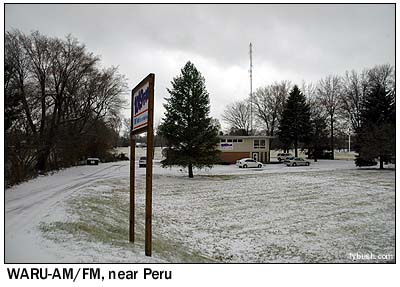
|
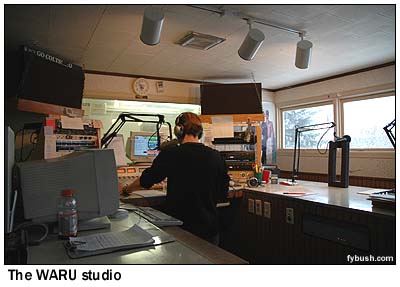
|
And so began our first big tower adventure of 2005, with a nighttime slide down US 24 from Fort Wayne to Peru, the town about halfway between Indianapolis and South Bend that calls itself "The Circus City." (The Circus Historical Society has been holding its annual conventions there since the fifties, you see...)
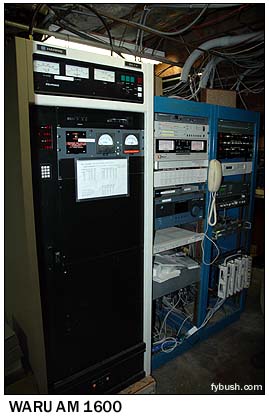 It
was right around that same time that WARU signed on the air,
as a 1000-watt daytimer on 1600. WARU-FM came along in 1965,
as a class A on 98.3, later (much later - 1999) moving to 98.5.
In more recent years, a second FM joined the group - WMYK in
nearby Roann, a class A on 101.9. And last year, WMYK and WARU-FM
traded calls and formats. So when the first morning of our tour
dawns with a visit to the WARU studios and AM transmitter site,
just east of downtown Peru, what we find there is WARU AM 1600
and FM 101.9, simulcasting an 80s-hits format.
It
was right around that same time that WARU signed on the air,
as a 1000-watt daytimer on 1600. WARU-FM came along in 1965,
as a class A on 98.3, later (much later - 1999) moving to 98.5.
In more recent years, a second FM joined the group - WMYK in
nearby Roann, a class A on 101.9. And last year, WMYK and WARU-FM
traded calls and formats. So when the first morning of our tour
dawns with a visit to the WARU studios and AM transmitter site,
just east of downtown Peru, what we find there is WARU AM 1600
and FM 101.9, simulcasting an 80s-hits format.
In between handling school closing announcements and other duties, GM Tom Bugg shows us around the place - a small office on the second floor, a newsroom/sales office, a production studio, a tiny closet-sized studio that had been used for classic hits WMYK before that station's studios moved to Kokomo, 20 miles south (we'll catch up with them in next week's installment), and the air studio, complete with a live midday jock!
Downstairs, Tom's office faces the front door, and the rest of the space is filled with storage and the AM transmitter, feeding the short tower out back.
From Peru, we head east on back roads to the US 24 bypass, where we see the WARU-FM tower on our way to Wabash, the next town on our busy agenda. We pass the tower of WJOT-FM (105.9) on the north side of town before heading through downtown Wabash (it's seen better days) to South Wabash Street, where we spot the nifty little building that's home to the WJOT studios, with the tower of WJOT (1510) out back.
The 250-watt daytime AM station - the erstwhile WAYT - has been a sister to WARU for its entire existence, as we deduce from the matching details on the stations' buildings (there's a concrete block with "1955" engraved in it above the front door at WJOT, just as there's one with "1954" above the door at WARU), and the FM's been around since 1993, originally as WWIP. Today WJOT and WJOT-FM are simulcasting oldies under the ownership of Mid-America Radio Group, by far the biggest operator in the communities we'll be visiting on this trip.
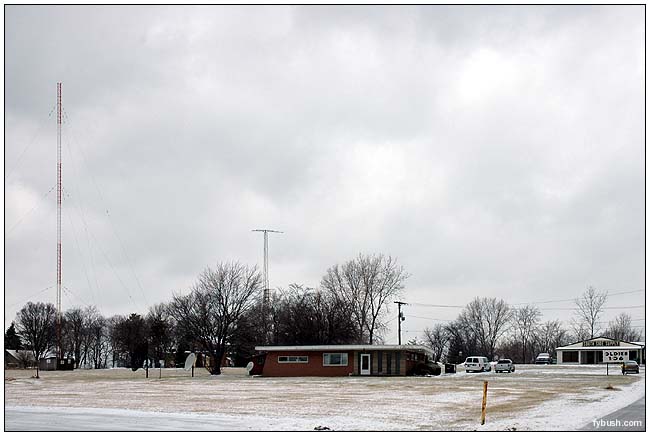
That's the whole building right there - perhaps 800 square feet, in all, but a beautiful example of small-town radio at its best. Bill Barrows, the station's news and sports director (and a high school coach when he's not doing radio), is happy to show the place off to us, including all the posters on the walls for the oldies band that includes WJOT staffers.
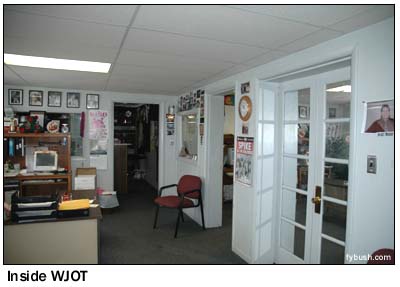
|
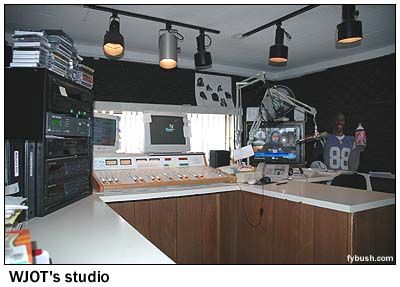
|
Everything's right here - a small office area inside the front door, the air studio just to the left of the door, another small studio beyond that that's used when the AM splits off for sports coverage, a little rack holding the AM transmitter next to that, and, oh yes - "Studio C," a little closet to the right of the front door that's now used for storage but was once the newsroom. It's a nice little operation!
Just down Wabash is the office of WJOT's competition, country WKUZ (95.9), and we pass its tower as well as we continue south toward our next destination, Marion.
The roads get slicker and the ice gets thicker as we approach Marion by way of several more towers - one for country WCJC (99.3 Van Buren) and Ball State public-radio relay WBSW (90.9 Marion), another for big class B signal WMRI (106.9 Marion) and several LPTVs, and after lunch at the aptly-named "Icehouse" restaurant, we head into the center of town to discover that the power's out. (WBSW had only a dead carrier, which might have been a clue to us that there were even bigger ice problems to the south; Ball State's main campus in Muncie had no power, either.)
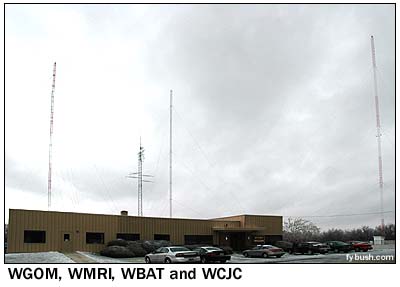
|
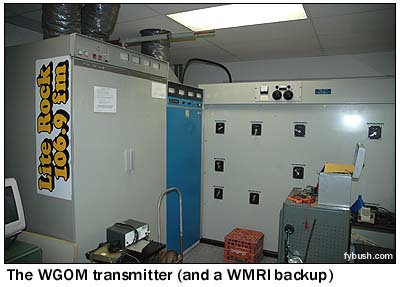
|
But we've come this far, and they're waiting for us at the Mid-America stations here, too - so we push on to the southeast side of town and the three towers of WGOM (860).
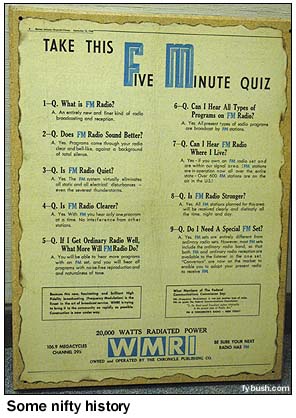 There's a nifty
history here: while WGOM has been on the air since 1955, its
FM sister WMRI goes back all the way to 1948, when it signed
on as the radio station of the Marion Chronicle.
There's a nifty
history here: while WGOM has been on the air since 1955, its
FM sister WMRI goes back all the way to 1948, when it signed
on as the radio station of the Marion Chronicle.
Check out the ad that's been carefully preserved and now sits
in a WMRI sales office -
"If I Get Ordinary Radio Well, What More Will FM Radio Do?"
and "Do I Need A Special FM Set?" are
among the questions. ("Lots," and "yes,"
by the way.)
(And by popular demand, you can now click on the image to the left to see a larger, more readable version of the Quiz...)
In any case, WMRI was one of the smaller FM stations to survive through the darkest days of FM in the fifties and early sixties, and for many years it was a beautiful music beacon heard well as far north as Fort Wayne and south almost to Indianapolis. More recently, it's become "Lite Rock 106.9," while the AM side's gone talk.
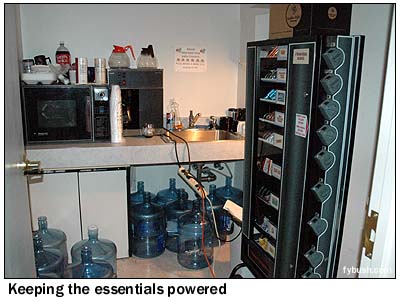 In
2003, longtime owner Bomar Broadcasting sold WMRI/WGOM to Mid-America,
which already owned crosstown WBAT (1400) and WCJC, and within
a few months before our visit, WBAT/WCJC had moved into the WMRI/WGOM
building, which now boasts a new addition (on the left side of
the photo above.)
In
2003, longtime owner Bomar Broadcasting sold WMRI/WGOM to Mid-America,
which already owned crosstown WBAT (1400) and WCJC, and within
a few months before our visit, WBAT/WCJC had moved into the WMRI/WGOM
building, which now boasts a new addition (on the left side of
the photo above.)
We know all this history because of "Doc," the veteran WBAT engineer who's sitting right in the front lobby making sure that everything's running OK in the absence of electricity. There's a generator keeping the studio side of the building powered, and a big stack of pizzas keeping the staff fed (it's nice to be a radio station when the power goes out!), but there's also an extension cord running over to the office side of the building to keep that most important of all devices juiced up. (A radio station without a coffee machine isn't a radio station, you know.)
In any case, we're treated to a nice tour of the place, including the big transmitter room that houses the WGOM transmitter (it's 1000 watts by day, 500 very directional watts at night), the WGOM phasor, the backup for WMRI and a variety of STLs to feed the other stations; the studios for WCJC and WMRI (the latter with a live jock); and the big studio visible from the lobby that's used for WBAT's morning show and for running WGOM's automation the rest of the day - and of course more history from Doc.
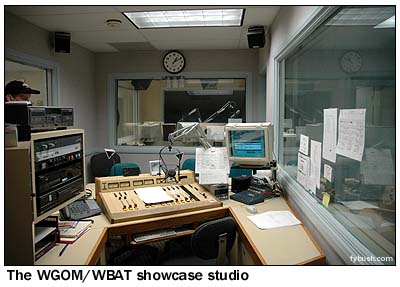
|
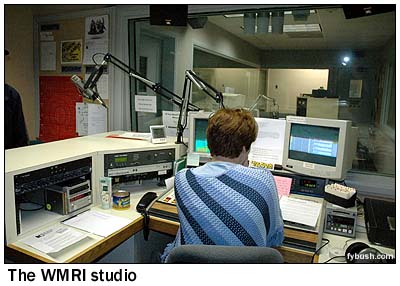
|
That history includes an offer to go check out the old WBAT/WCJC facility on the other side of town, where the WBAT transmitter still resides, along with one of the neatest signs in all of radio. Could we say no to that? Of course not (especially since we were headed that way anyway), and so we followed one of the WBAT engineers across town for a rendezvous with some Marion radio heritage.
But for that, you'll have to wait until next week, when we'll also show you what's doing in Kokomo. Stay tuned!
 It's here - the
2005 Tower Site Calendar is now shipping! Click
here for ordering information!
It's here - the
2005 Tower Site Calendar is now shipping! Click
here for ordering information!
- Previous Site of the Week: Atlanta Revisited, part IV
- Next Week: An Icy Slide 'Round Central Indiana, part II
- Site of the Week INDEX!
- How can you help support Site of the Week? Click here!
- Submit your suggestions for a future Site of the Week!
